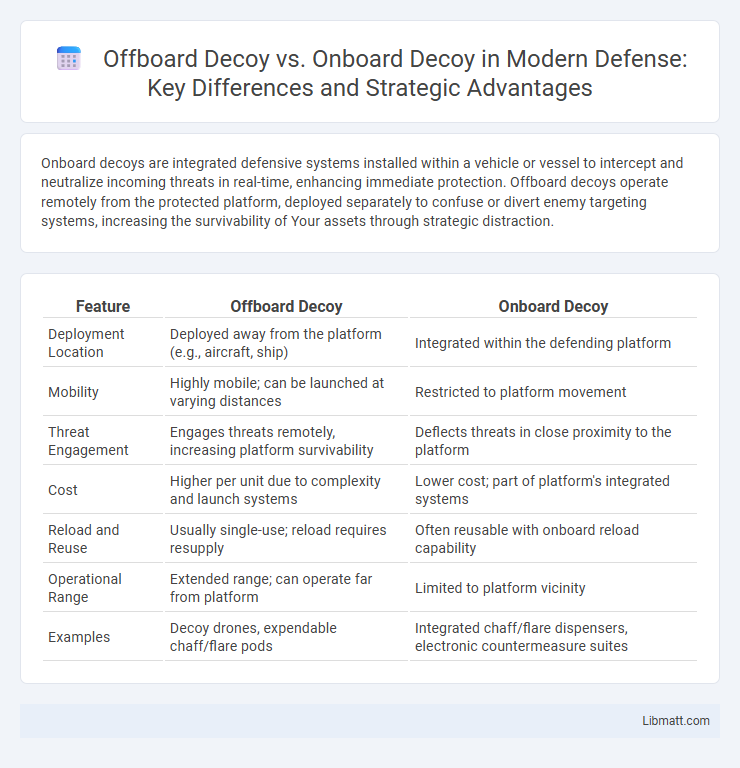Onboard decoys are integrated defensive systems installed within a vehicle or vessel to intercept and neutralize incoming threats in real-time, enhancing immediate protection. Offboard decoys operate remotely from the protected platform, deployed separately to confuse or divert enemy targeting systems, increasing the survivability of Your assets through strategic distraction.
Table of Comparison
| Feature | Offboard Decoy | Onboard Decoy |
|---|---|---|
| Deployment Location | Deployed away from the platform (e.g., aircraft, ship) | Integrated within the defending platform |
| Mobility | Highly mobile; can be launched at varying distances | Restricted to platform movement |
| Threat Engagement | Engages threats remotely, increasing platform survivability | Deflects threats in close proximity to the platform |
| Cost | Higher per unit due to complexity and launch systems | Lower cost; part of platform's integrated systems |
| Reload and Reuse | Usually single-use; reload requires resupply | Often reusable with onboard reload capability |
| Operational Range | Extended range; can operate far from platform | Limited to platform vicinity |
| Examples | Decoy drones, expendable chaff/flare pods | Integrated chaff/flare dispensers, electronic countermeasure suites |
Introduction to Decoy Systems
Decoy systems are critical for modern military defense, designed to mislead incoming threats by simulating the presence or signature of valuable assets. Offboard decoys are deployed away from the protected platform, creating a separate target that distracts enemy sensors and weapons, enhancing protection through distance and complexity. Onboard decoys, integrated directly onto the host vehicle or vessel, provide immediate countermeasures by emitting misleading signals or deploying chaff and flares to confuse guided munitions in close proximity.
Defining Offboard Decoy Technology
Offboard decoy technology refers to countermeasure systems deployed externally from the host platform, such as drones or towed devices, to divert incoming threats like missiles away from the original target. Unlike onboard decoys, which are integrated within the defense system of the vehicle or aircraft, offboard decoys operate independently and enhance survivability by increasing the engagement area and confusion for threat sensors. These systems utilize electronic warfare techniques, infrared signatures, or radar reflectors to simulate the host, effectively misleading adversaries and improving mission success rates.
Overview of Onboard Decoy Solutions
Onboard decoy solutions are defense systems integrated directly into the platform they protect, such as ships or aircraft, designed to mislead incoming threats like missiles by emitting signals or deploying countermeasures. These systems offer continuous protection by reacting in real-time to threats, enhancing survivability without requiring external support. Your choice of onboard decoys can significantly improve threat response time and reduce the risk of successful enemy targeting.
Key Differences: Offboard vs Onboard Decoys
Offboard decoys are deployed away from the host platform, enhancing survivability by attracting or confusing incoming threats at a distance, while onboard decoys are installed directly on the platform to provide immediate, localized defense against missiles or radar targeting. Offboard systems offer greater flexibility and can protect multiple assets by creating extended electronic or physical barriers, whereas onboard decoys focus on rapid activation and close-range threat mitigation. Key differences include deployment location, range of protection, and operational scope, with offboard decoys suitable for layered defense strategies and onboard decoys optimized for direct, real-time countermeasures.
Operational Tactics and Deployment Methods
Offboard decoys are deployed remotely from aircraft or ships, providing flexibility in tactical positioning and allowing for broader area coverage against incoming threats such as missiles or radar detection. Onboard decoys, integrated within the host platform, enable rapid activation and immediate response to threats at close proximity, enhancing survivability during high-threat encounters. Both systems complement operational tactics by either extending the defensive perimeter or reinforcing point defense, depending on mission requirements and threat environments.
Effectiveness Against Modern Threats
Offboard decoys provide enhanced effectiveness against modern threats by creating multiple false targets away from your vessel, confusing advanced missile guidance systems and improving survivability. Onboard decoys, while quicker to deploy, are limited by proximity and may be less effective against sophisticated sensors and multi-spectral seekers used in current missile technology. Your defense strategy benefits from integrating offboard decoys to address the evolving complexity of modern anti-ship threats.
Integration with Existing Defense Systems
Offboard decoys operate independently from the aircraft, allowing flexible deployment and integration with a wider range of existing defense systems, enhancing threat dispersal and system survivability. Onboard decoys are integrated directly into the platform's hardware, providing seamless communication and synchronization with onboard sensors and electronic warfare suites, which optimizes real-time threat response. Your choice between offboard and onboard decoys can impact the compatibility and effectiveness of your overall defense system integration.
Cost and Logistics Considerations
Offboard decoys generally incur higher initial costs due to deployment platforms and increased logistical support but offer scalability and flexibility in diverse operational theaters. Onboard decoys are more cost-effective with integrated systems reducing maintenance complexity, though they limit the number of decoys available per aircraft. Budget allocation must balance the cost-efficiency of onboard solutions against the operational versatility and replenishment demands of offboard decoys.
Challenges and Limitations
Offboard decoys face challenges such as limited maneuverability and shorter operational range due to their physical separation from the host platform. Onboard decoys are constrained by the available space, power, and integration complexity within the host system, impacting their deployment flexibility. Both decoy types encounter limitations in adapting to evolving threat environments and advanced electronic countermeasures.
Future Trends in Decoy Technologies
Future trends in decoy technologies emphasize enhanced offboard decoy systems that offer greater flexibility and increased range compared to traditional onboard decoys. Offboard decoys leverage autonomous drone platforms to deploy countermeasures at standoff distances, improving survivability against advanced missile threats. Your defense strategy can benefit from integrating these adaptive offboard technologies with existing onboard decoys for a comprehensive layered protection approach.
offboard decoy vs onboard decoy Infographic

 libmatt.com
libmatt.com